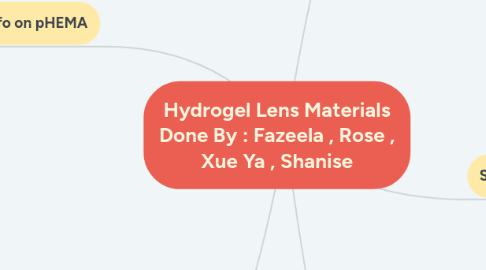
1. More Info on pHEMA
1.1. 1962
1.1.1. Sold in Europe
1.1.1.1. Disappointing sales
1.2. 1965
1.2.1. licence for American rights to technology bought over from Czechs
1.3. 1971: Bausch & Lomb
1.3.1. Refined spin-casting techniques
1.3.2. Obtained FDA approval
1.3.3. Became widely popular!!!
1.3.3.1. PROBLEMS
1.3.3.1.1. Hypoxia
1.3.3.1.2. Solution toxicity
1.3.3.1.3. Lens spoilage
2. Conventional Hydrogel Materials
2.1. Low Water Content
2.1.1. Advantage
2.1.1.1. Higher Refractive Index
2.1.1.2. More Rigid , Easier To Handle
2.1.1.3. More Wettable
2.1.2. Disadvantage
2.1.2.1. Low DK
2.1.2.2. More Rigid , Less Comfortable
2.1.2.3. Thin Lens , Difficult To Handle
3. Silicone Hydrogel
3.1. High Water Content
3.1.1. Advantage
3.1.1.1. High DK
3.1.1.2. More Flexible
3.1.1.3. Returns Back To Original Shape After Deformation
3.1.2. Disadvantage
3.1.2.1. Tear Easily
3.1.2.2. Lower Refractive Index
3.1.2.3. More Deposit Prone
4. Soft Lens Material Classification
4.1. USAN Identity
4.1.1. each chemical entity given a name
4.2. FDA Classification Scheme (water content and ionic content) - Group I, II, III, IV
4.2.1. Group I, II, III, IV
4.2.2. Low water content materials (group i, iii)
4.2.2.1. ADVANTAGES
4.2.2.1.1. more rigid, easier to handle
4.2.2.1.2. any manufacturing method can be used
4.2.2.2. DISADVANTAGES
4.2.2.2.1. less flexibility (more rigid, less comfortable)
4.2.2.2.2. thin lens, difficult to handle
4.2.2.3. restore shape fast after deformation
4.2.3. High water content materials (ii, iv)
4.2.3.1. ADVANTAGES
4.2.3.1.1. more flexible
4.2.3.2. DISADVANTAGES
4.2.3.2.1. tears easily
4.2.3.2.2. higher dehydration rate on the eyes
4.2.3.2.3. thicker lens, due to high water
4.2.4. Non- ionic materials (i, ii) (<0.2% ionic material)
4.2.4.1. ADVANTAGES
4.2.4.1.1. less deposit prone
4.2.4.1.2. do not bind charge particles
4.2.4.2. DISADVANTAGES
4.2.4.2.1. denature tear proteins more
4.2.4.2.2. less wettable ( no - charge on lens surface)
4.2.5. Ionic materials (iii, iv) (>0.2% ionic material)
4.2.5.1. ADVANTAGES
4.2.5.1.1. more wettable ( - charge on lens surface)
4.2.5.1.2. denature tear protein less
4.2.5.2. DISADVANTAGES
4.2.5.2.1. temperature sensitive
4.2.5.2.2. deposits more readily
4.2.5.2.3. more susceptible to pH changes
4.2.5.2.4. deposits may be bound
5. How is it formed?
5.1. HEMA
5.1.1. Hydroxyl group
5.1.2. PMMA
5.2. pHEMA
5.2.1. polymerising 2 or more HEMA monomers

